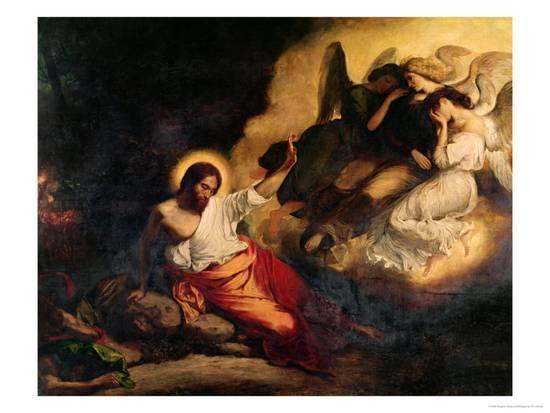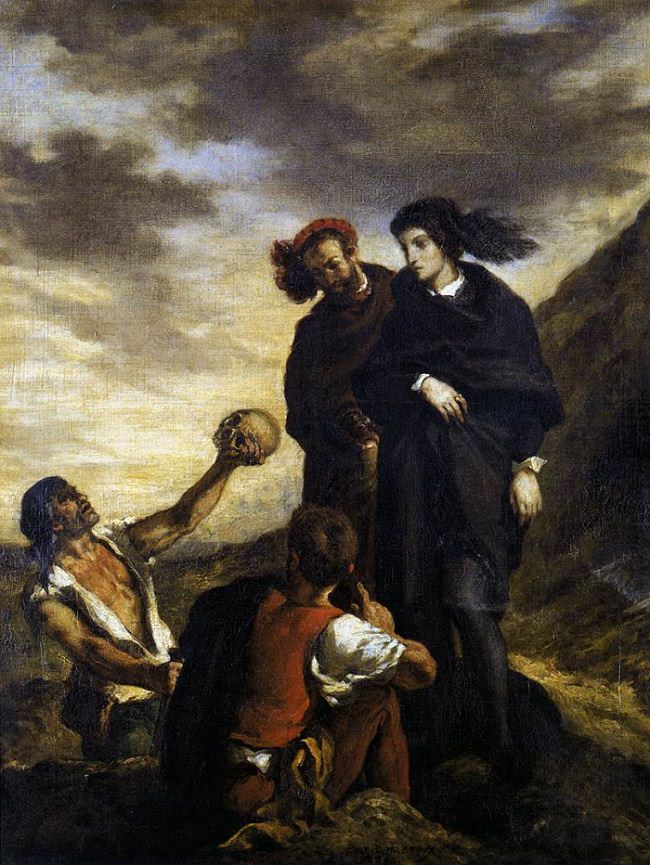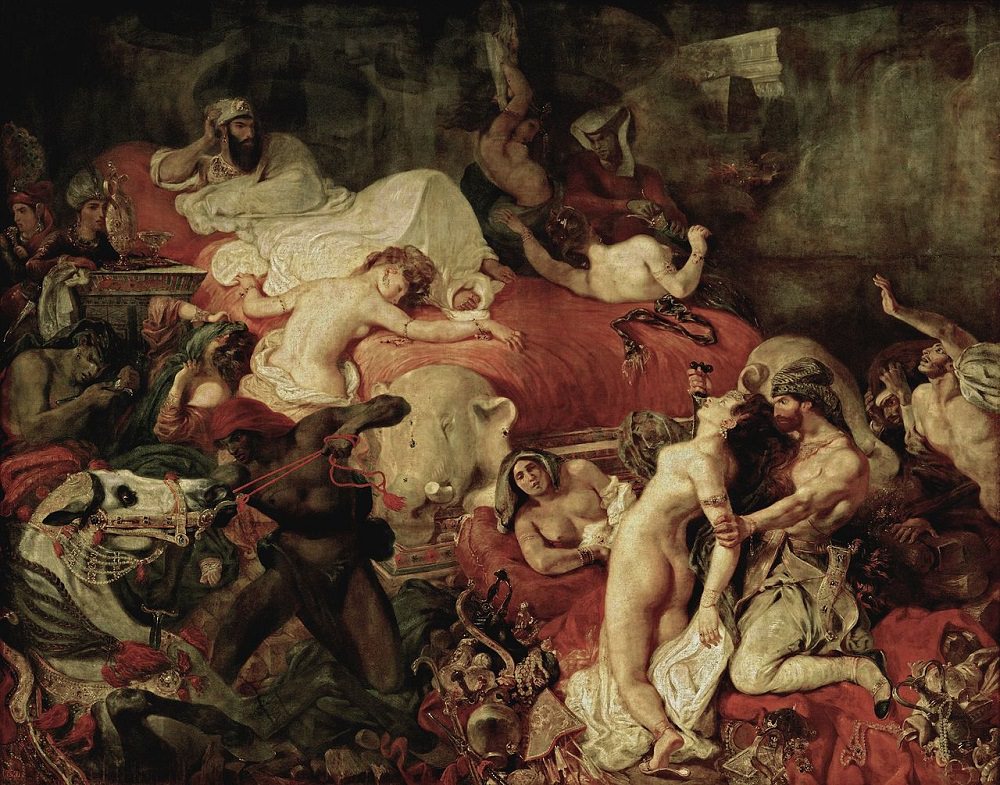The Spirit of Romanticism: Eugène Delacroix at the Metropolitan Museum of Art
The current exhibition of Eugène Delacroix (1798-1863) at New York’s Metropolitan Museum
of Art – the first of its kind to be mounted in North America – is indeed an extraordinary
revelation. Delacroix was one of the great creative minds of the nineteenth century: an artist who
embodied the spirit of Romanticism, a dramatist and virtuoso of coloration who never ceased to
experiment, to take inspiration from the old masters – from Veronese and Rubens, Rembrandt
and Caravaggio – whose works he would often copy at the Louvre, “that book from which we
learn to read,” as Cézanne put it.
 The show commences with Delacroix’s first commission for a religious painting: a monumental
The show commences with Delacroix’s first commission for a religious painting: a monumental
rendition of Christ in the Garden of Olives (1824-26). This ambitious work departs from
traditional approaches to the scene which would typically include a single angel – Delacroix
instead gives us three life-sized winged females hovering in mid-air. Christ rests his body on two
large rocks, propped up by his right arm; while with his face turned downwards in an attitude of dejection, he acknowledges the presence of the heavenly trio by raising his left hand to them, as if to say that he is beyond their powers of consolation. It is a picture that emphasizes Christ’s humanity, and already we see that strikingly vivid and sensuous use of color, for which Delacroix would be known.
From January to July 1832, Delacroix journeyed to North Africa, accompanying a diplomatic
mission to Morocco, followed by a visit to Algiers. The trip would prove to be a transformative
one for the painter, who by that time had already made a name for himself. It was, for Delacroix,
a journey back in time, a vibrant encounter with “living antiquity” as he put it, writing to a friend
while in Tangier: “Imagine… what it is to see lying in the sun, walking about the streets,
cobbling shoes, figures like Roman consuls, like Cato or Brutus…”
One of the many great works to emerge from his experience of North Africa is the Women of
Algiers in Their Apartment (1834), a large-scale painting that depicts three Algerian women
seated comfortably on the rugs that cover the floor of their private quarters. To the left, one
reclines casually on a pillow, gazing out towards the viewer and drawing us irresistibly into the picture. The other two incline their heads towards each other, apparently engaged in some quiet conversation; while to the far right a female black servant takes her leave.
The painting is especially notable for its use of flochetage – a technique that Delacroix
developed, which involves the application of complementary, closely related colors next to one
another, so that the colors mix in the eye and brain rather than on the palette. Such a technique
recognizes and utilizes the active role of the viewer in constituting the work of art as an aesthetic
object. This assertion of the constitutive activity of the mind – its vital participation in creating
the object – is in many ways the essential thread that runs through and unites Delacroix’s work,
and places him squarely at the forefront of that shift which would mark the advent of modern art.
It is no accident that Delacroix would have a profound influence on impressionists and post-
impressionists, from Renoir and Cézanne, to Seurat and Van Gogh.
 Given his keen awareness of the active role of the mind it is not so surprising that we should find Delacroix returning repeatedly to the scene of Hamlet and Horatio in the Graveyard (in 1835 and
Given his keen awareness of the active role of the mind it is not so surprising that we should find Delacroix returning repeatedly to the scene of Hamlet and Horatio in the Graveyard (in 1835 and
again in 1839). In many ways, Hamlet is the quintessential modern subject, bearing witness in virtually everything he says and does to the infinite nature of consciousness. In the 1835 painting, a gravestone has literally become Prince Hamlet’s throne, and the graveyard his kingdom – in other words, his surroundings are a reflection of his melancholic and perhaps even suicidal thoughts.
Cleopatra and the Peasant (1838) revisits some of the themes we encounter in the scene of
Hamlet and Horatio. Delacroix does not depict the queen of Egypt at the moment when she is
dying, as baroque painters typically would have done (Guido Cagnacci provides such an example). Rather, Delacroix chooses instead to render the queen when she is contemplating her death, which would be accomplished through the poisonous asp – brought to her, in this case, by a burly peasant who has hidden the serpent in a basket of figs. Like Hamlet, Cleopatra could be said to be pondering the vanity and transience of worldly power, wealth and fame. The crucial point is that it is her state mind, not her death throes, which interests the painter.
The show includes two versions of the Death of Sardanapalus – an oil sketch from 1826-27,
which served as a study for one of the largest, most violent and controversial works of
Delacroix’s career. The other, from 1845-46, is a reduced replica of the massive 16-feet wide
Salon painting which was shown in 1826-27. The scene is one of unmitigated violence: during
the siege of his palace, Sardanapalus, the last king of Assyria, had ordered the destruction of all
his possessions, including the women of his harem, and even the horses. We behold this murder
and mayhem unfolding all about the king, clothed in white robes, reclining impassively on a red-
draped bed, as the violence engulfs his lavish hall. Moments later, the suicidal king would take
his own life, rather than be vanquished by his enemies.

One of the great highlights of the show is its inclusion of oils, watercolors, graphite sketches and
lithographs that record Delacroix’s fascination with animals – including especially lions, tigers,
and horses. Some of these works were produced during his visits to the menagerie at the Jardin
des Plantes in Paris, where he seems to have studied the features of the lion in particular. It is
particularly notable that Delacroix is sensitive to the way that animals and humans echo through
one another – observing in his journal, for example, how “the foreleg of the lion was like the
monstrous arm of a man.”
For Delacroix, human-animal intertwining was much more than just a pictorial theme. Look at
the Lion Hunt, for example, of which there are several versions; including a monumental
painting from 1855 which was partially destroyed in an 1870 fire (visitors will at least have a
chance to see the bottom half of the painting). Delacroix’s admiration for animals was immense,
as is clear from a painting such as Young Tiger Playing with Its Mother (1830):
 the dignity of the mother’s pose is unmistakable and striking – even suggestive that, for Delacroix, the relation between humanity and animality is fundamentally not a hierarchical, but rather a lateral relation. Delacroix is often remembered, first and foremost, as a brilliant colorist – as a painter who championed the significance of vivid color and lively brushwork above that of line and delineation; in contrast to his great neoclassical contemporary and rival, Jean-Auguste-
the dignity of the mother’s pose is unmistakable and striking – even suggestive that, for Delacroix, the relation between humanity and animality is fundamentally not a hierarchical, but rather a lateral relation. Delacroix is often remembered, first and foremost, as a brilliant colorist – as a painter who championed the significance of vivid color and lively brushwork above that of line and delineation; in contrast to his great neoclassical contemporary and rival, Jean-Auguste-
Dominique Ingres. Van Gogh would observe that Delacroix’s work “speaks a symbolic language through color itself.” The Met’s retrospective has the merit however of showing how Delacroix
was also able to rein in his palette, to drastically limit his range of colors, and explore the
haunting effects of chiaroscuro in works that pay homage to the painter Caravaggio. The
Lamentation, or Christ at the Tomb (1847-48) demonstrates the way in which Delacroix could
paint with a deep sense of pathos, curtailing the light, while achieving a formal unity and balance
that was notoriously lacking in some of his earlier works. The only source of luminosity is the
body of Christ himself, while the mourners gathered around him seem to partake, in varying
degrees, of the light which his flesh itself exudes.
This exhibition has immense riches in store for the visitor who is able to take their time in each
gallery. Delacroix is an artist who produced works that are indeed a “feast for the eye”, which he
once stated is the primary merit of a painting – with patient and prolonged viewing however one
discovers that his art is as much a feast for the mind. “Painting is life itself,” he once wrote. More
than a genius of color, and imaginative narrative compositions, Delacroix’s greatness is
inseparable from his acute attention to the inner life, the interiority, of his subjects – be they
human or animal – and his ability to engage the viewer so that he becomes more than a passive
spectator. At his best, Delacroix’s work is able to touch us at the deepest level, to make us feel
the mystery at the heart of existence, and quicken our sense of the unity of living things.


















